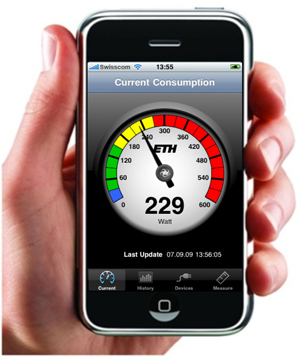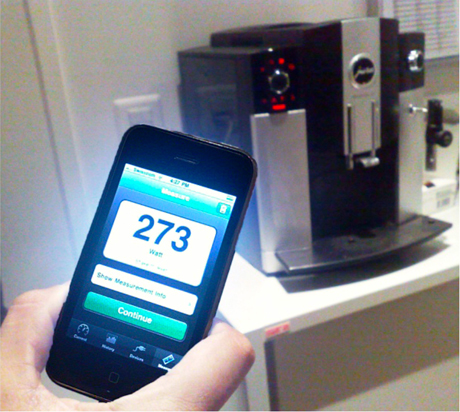by Markus Weiss, Friedemann Mattern and Christian Beckel
“Smart” information and communication technologies can contribute to a more thrifty use of energy. By connecting smartphones to digital electricity meters, we can process electricity consumption data and provide household-specific feedback. Bringing users into the loop then enables them to learn about their personal consumption-related behaviour and optimize it in order to conserve energy.
Domestic electricity consumption is continuously increasing and now accounts for about one third of the total electrical energy produced in Europe. Many individuals would be interested in saving energy (and thus also carbon dioxide as well as money), but they lack information on their consumption. Indeed, feedback on household electricity usage is typically only provided by monthly (or even annual) utility bills and therefore remains opaque to most households. Few people know how much electricity they consume, and even fewer have any idea how much electricity they use for a particular purpose (eg lighting). And even those who do have a fair understanding of their consumption patterns rarely receive guidance about the changes that would have the biggest impact on their electricity bills.
Fortunately, emerging “smart” information and communication technologies can help to make electricity consumption visible to individuals [1]. For instance, next-generation digital electricity meters (“smart meters”) enable detailed electricity consumption information to be captured, processed, and communicated at frequent intervals (eg once per second). As smart meters are replacing traditional electricity meters in large parts of Europe, there is now a unique opportunity to realize comprehensive consumer feedback systems that consist of much more than mere remote metering applications.
At ETH Zurich we seized the opportunity offered by this development. Within the eMeter project we connected smart meters to smartphones [2]. As they are almost always connected to the Internet and within reach of the user, using smartphones to visualize electricity consumption eliminates the need for costly in-house displays. The resulting system not only fits unobtrusively into the home environment, but also provides fine-grained electricity consumption information in real-time, enabling occupants to better understand their electricity consumption.
The sensing and feedback system we developed consists of three loosely
coupled components that are responsible for data acquisition, data handling, and data visualization. The first component consists of a state-of-the-art smart electricity meter that monitors the total household load. We extended the meter’s functionality by incorporating a gateway module implemented on an embedded computing device equipped with flash storage and a WiFi communication module. This matchbox-sized gateway module also holds the second component of our system, a web server with a database. It manages the recorded metering data, performs data analysis, and handles incoming requests from the user interface. The carefully designed user interface, which forms the third component of our system, is realized as a mobile phone application on Android, iOS, and Windows Phone platforms.

Figure 1: Live visualization of current household electricity consumption
Occupants can easily familiarize themselves with their electricity consumption and obtain feedback in real-time by using the following smartphone application functions:
- a live visualization of current total electricity consumption (see Figure 1)
- a historical view of electricity consumption over time (also indicating the resulting costs)
- a measurement function to interactively measure the consumption of any switchable electrical appliance in the house
- a household-specific recommendation service on how to save energy. Most notably the latter two functions provide users with the simple feedback advice they require in order to ultimately conserve energy [3].
The measurement function (see Figure 2) allows users to break down their consumption and learn how much a specific household appliance or device consumes. To perform a measurement, the user activates the process by pressing the start button on the smartphone application and then turns a device on or off. Within seconds, the measurement algorithm then determines and displays the electricity consumption of the device together with information on its energy efficiency and possible energy saving tips.

Figure 2: Measuring the standby power of a specific household appliance
The recommendation service analyzes the captured electricity consumption data. It provides feedback that is individually tailored to the household and explains how its consumption relates to that of comparable households. It does so by computing the household´s standby power as well as the consumption of cooling appliances (ie fridges and freezers) based on their characteristic quasi-cyclic load curves.
Our eMeter prototype was used in several households in Zurich for more than a year. Study participants reported that their energy-saving knowledge substantially increased thanks to the system. However, the application’s usage rate dropped over the course of the experiment once the participants’ initial curiosity had been satisfied. Owing to this phenomenon, which is well known in the scientific community, concepts are required that motivate users to be involved with the system over an extended period of time.
In a follow-up project, we are currently investigating algorithms to automatically generate enhanced household-specific saving recommendations. Inferring occupancy from smart meter data, for instance, enables us to provide feedback on how much electricity a household consumes when no one is at home. Using methods developed in machine learning and data mining, we are further investigating ways of generating a pie chart that shows the contribution of each relevant appliance to the overall consumption bill. To validate our algorithms relative to “ground truth”, we equipped six of our test households with additional sensors that measure electricity consumption at individual power outlets and reliably determine when occupants are at home.
The eMeter system demonstrates that smart ICT can collect, analyze, and present valuable real-time data on electricity consumption without costly additional hardware. It provides guidance (for example in the form of household-specific recommendations) that is crucial for occupants who want to conserve energy. Transforming our prototype, or at least parts of it, into a real product is the next logical step. We are cooperating with smart meter manufacturers and electric utility companies to work towards this goal.
Link:
www.vs.inf.ethz.ch/res/show.html?what=energy
References:
[1] F. Mattern, T. Staake, M. Weiss: “ICT for Green – How Computers Can Help Us to Conserve Energy”, in proc. e-Energy 2010, ACM, pp. 1-10.
[2] M. Weiss, T. Graml, T. Staake, F. Mattern, E. Fleisch: “Handy feedback: Connecting smart meters with mobile phones”, in proc. MUM 2009, ACM.
[3] M. Weiss, C. Loock, T. Staake, F. Mattern, E. Fleisch: “Evaluating Mobile Phones as Energy Consumption Feedback Devices”, in: P. Sénac, M. Ott, A. Seneviratne (Eds.): MobiQuitous 2010, LNICST 73, pp. 63-77, 2012.
Please contact:
Friedemann Mattern
ETH Zurich, Switzerland
E-mail:











